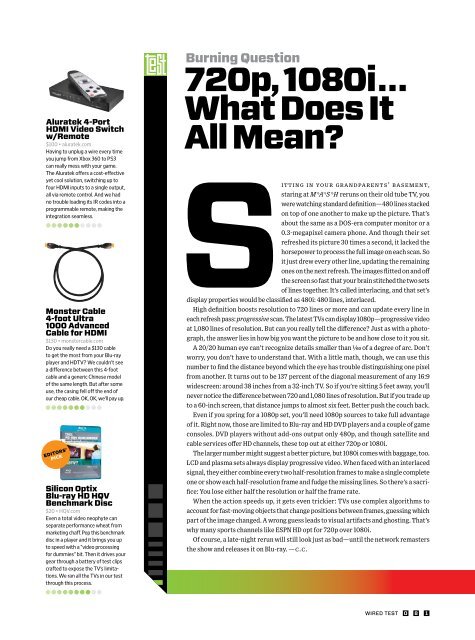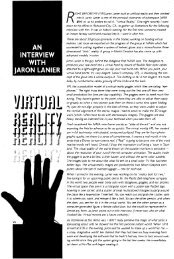You also want an ePaper? Increase the reach of your titles
YUMPU automatically turns print PDFs into web optimized ePapers that Google loves.
Aluratek 4-Port<br />
HDMI Video Switch<br />
w/Remote<br />
$100 • aluratek.com<br />
Having to unplug a wire every time<br />
you jump from Xbox 360 to PS3<br />
can really mess with your game.<br />
The Aluratek offers a cost-effective<br />
yet cool solution, switching up to<br />
four HDMI inputs to a single output,<br />
all via remote control. And we had<br />
no trouble loading its IR codes into a<br />
programmable remote, making the<br />
integration seamless.<br />
Monster Cable<br />
4-foot Ultra<br />
1000 Advanced<br />
Cable for HDMI<br />
$130 • monstercable.com<br />
Do you really need a $130 cable<br />
to get the most from your Blu-ray<br />
player and HDTV? We couldn’t see<br />
a difference between this 4-foot<br />
cable and a generic Chinese model<br />
of the same length. But after some<br />
use, the casing fell off the end of<br />
our cheap cable. OK, OK, we’ll pay up.<br />
EDITORS’<br />
PICK<br />
Silicon Optix<br />
Blu-ray HD HQV<br />
Benchmark Disc<br />
$20 • HQV.com<br />
Even a total video neophyte can<br />
separate performance wheat from<br />
marketing chaff. Pop this benchmark<br />
disc in a player and it brings you up<br />
to speed with a “video processing<br />
for dummies” bit. Then it drives your<br />
gear through a battery of test clips<br />
crafted to expose the TV’s limitations.<br />
We ran all the TVs in our test<br />
through this process.<br />
Televisions<br />
Burning Question<br />
720p, 1080i...<br />
What Does It<br />
All Mean?<br />
itting in your grandparents’ basement,<br />
staring at M*A*S*H reruns on their old tube TV, you<br />
were watching standard definition—480 lines stacked<br />
on top of one another to make up the picture. That’s<br />
about the same as a DOS-era computer monitor or a<br />
0.3-megapixel camera phone. And though their set<br />
refreshed its picture 30 times a second, it lacked the<br />
horsepower to process the full image on each scan. So<br />
it just drew every other line, updating the remaining<br />
ones on the next refresh. The images flitted on and off<br />
the screen so fast that your brain stitched the two sets<br />
of lines together. It’s called interlacing, and that set’s<br />
display properties would be classified as 480i: 480 lines, interlaced.<br />
High definition boosts resolution to 720 lines or more and can update every line in<br />
each refresh pass: progressive scan. The latest TVs can display 1080p—progressive video<br />
at 1,080 lines of resolution. But can you really tell the difference? Just as with a photograph,<br />
the answer lies in how big you want the picture to be and how close to it you sit.<br />
A 20/20 human eye can’t recognize details <strong>sm</strong>aller than 1⁄60<br />
S<br />
of a degree of arc. Don’t<br />
worry, you don’t have to understand that. With a little math, though, we can use this<br />
number to find the distance beyond which the eye has trouble distinguishing one pixel<br />
from another. It turns out to be 137 percent of the diagonal measurement of any 16:9<br />
widescreen: around 38 inches from a 32-inch TV. So if you’re sitting 5 feet away, you’ll<br />
never notice the difference between 720 and 1,080 lines of resolution. But if you trade up<br />
to a 60-inch screen, that distance jumps to almost six feet. Better push the couch back.<br />
Even if you spring for a 1080p set, you’ll need 1080p sources to take full advantage<br />
of it. Right now, those are limited to Blu-ray and HD DVD players and a couple of game<br />
consoles. DVD players without add-ons output only 480p, and though satellite and<br />
cable services offer HD channels, these top out at either 720p or 1080i.<br />
The larger number might suggest a better picture, but 1080i comes with baggage, too.<br />
LCD and pla<strong>sm</strong>a sets always display progressive video. When faced with an interlaced<br />
signal, they either combine every two half-resolution frames to make a single complete<br />
one or show each half-resolution frame and fudge the missing lines. So there’s a sacrifice:<br />
You lose either half the resolution or half the frame rate.<br />
When the action speeds up, it gets even trickier: TVs use complex algorithms to<br />
account for fast-moving objects that change positions between frames, guessing which<br />
part of the image changed. A wrong guess leads to visual artifacts and ghosting. That’s<br />
why many sports channels like ESPN HD opt for 720p over 1080i.<br />
Of course, a late-night rerun will still look just as bad—until the network remasters<br />
the show and releases it on Blu-ray. —c.c.<br />
WIRED TEST 0 8 1








